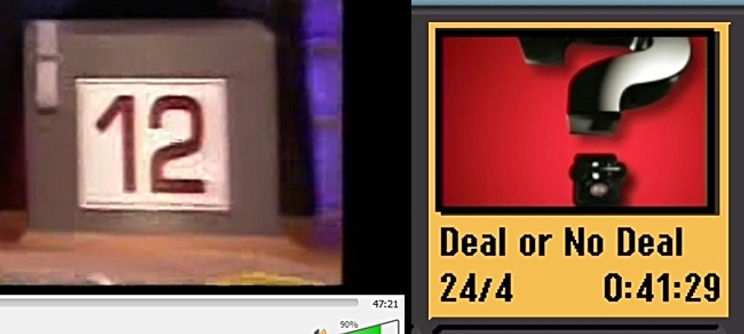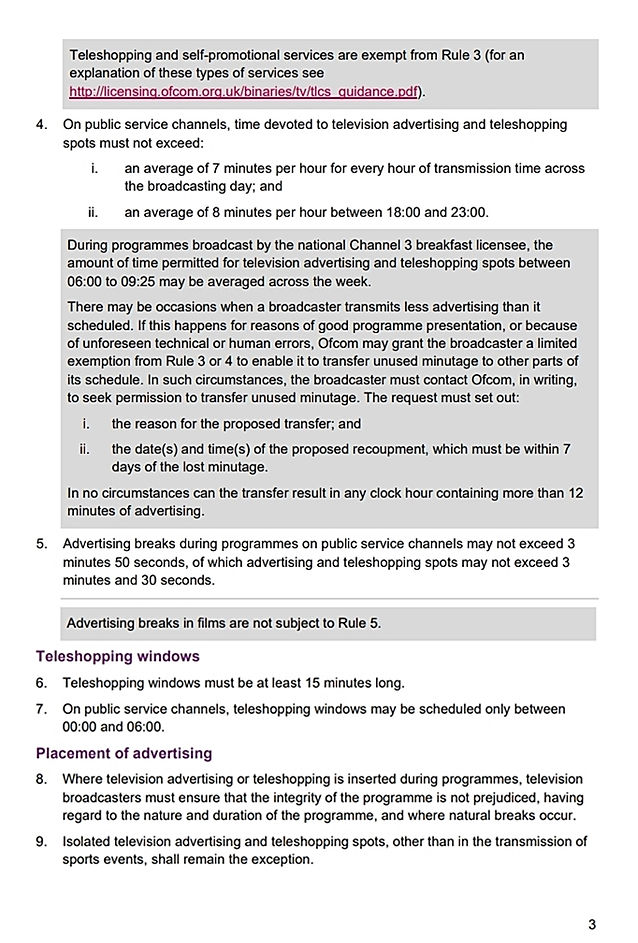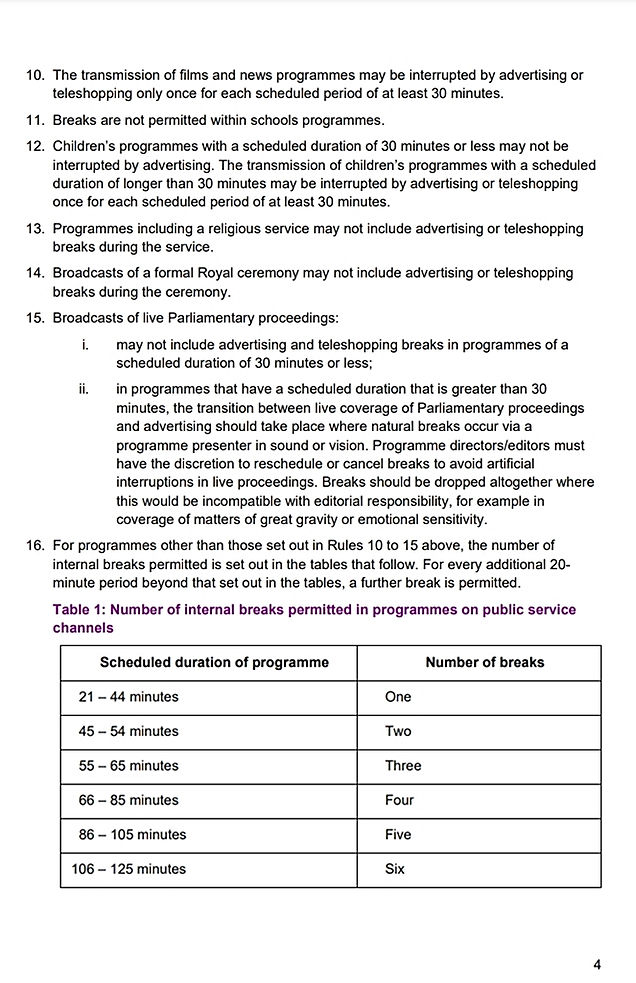20 minutes
of TV ad breaks!
(per hour)

Please note, the answers given to the ‘virtual interview’ questions in this exposé/article, are (by and large) in the ‘Public Domain’. See the TRUTH’s editorial page (the link to which can be found on the main contents page) for more.
Question: How long before there are 20 minutes of ad breaks per hour?
If the second series of ‘Killing Eve’ was anything to go by, it has already happened!
The eight episodes in the first series of the spy thriller, originally broadcast in America, had a run time of just under 43 minutes. Episodes of the second series, however, are 40 minutes in length. Meaning that, in a one hour broadcast there are 20 minutes of adverts.
In addition to researching how this came about, there is also the effects of ad breaks on a film or TV programme, especially those from decades gone by, effects that may just have you wondering: ‘Does the TV broadcaster’s interest lie with the advertiser, thereby demonstrating contempt for the viewer?’ All will gradually be revealed.
When ITV first broadcast British TV series: ‘The Professionals’, ‘Minder’ and ‘The Sweeny’, the episodes ran for 50 minutes within a total scheduled time of 1 hour. That meant there were 10 minutes of adverts and three ad breaks in total – the third ad break coming at the end.

In order to broadcast films without the need to interrupt them for 30 minutes to show ‘the News at Ten’, ITV took the unprecedented decision to move ‘News at Ten’ to 9pm, in direct competition with both Channel 5’s and the BBC’s 9pm news. Of course, ITV have since moved the news back to its old 10pm slot, as long ago as before the demise of the ITC. Furthermore, It was with an arrangement, a conditional arrangement at that, that ITV moved the News at ten back to its old time slot. The arrangement ITV made was 5 minute ad breaks, which meant 15 minutes of adverts per hour, something that other commercial broadcasters have since adopted, while some of them have been quite cheeky with it.
In 2000, shortly after I had SKY digital installed, Granada plus (now ITV4) began broadcasting ‘The Professionals’, only with four ad breaks instead of the original three, something they continued to do for well over a decade, 19 years as it now is. That meant, at least 5 minutes were cut from ‘The Professionals’, ‘Minder’ and ‘The Sweeny’, while ‘An audience with Billy Connolly’, also 50 minutes long, had 5 minutes removed from it. Not only that, but they, ITV, on one repeat broadcast, cut and moved the order of his comedy sketches around (I still have the original broadcast transferred from video to DVD). Thankfully, as recently as 13th June 2016, ITV4 transmitted the full 50 minute version with 15 plus minutes of adverts.
According to a line from the David Gates song, ‘If’, ‘A picture paints a thousand words’. A page from a paperback book can have as many as 413 words or more (depending on the size of the book, etc). How many pages from a book equally paint 5 minutes? And the answer is 11% (11 out of every 100).
Here is how that works out: Films, a certain amount of which are adapted from books, have various run times. Two 50 minute episodes of ‘Minder’ have a run time of 100 minutes; however, since 10 minutes are cut from two 50 minute episodes of the TV series, there is an 11% loss. (See editorial for how percentage calculations are made.)
Sony Movie channel. At 9 pm on 13th June 2019, which film did you broadcast?
Sony Movie channel: ‘Equilibrium, starring Christian Bale and Sean Bean.’
How long was the last but one ad break (the last ad break within the actual film)?
Sony Movie channel: ‘Over 6 minutes.’
On that evidence, and thank you Sony Movie channel for your honesty, since there are four ad breaks per hour, as noted above, four ad breaks, each one over 6 minutes long, would last over 24 minutes.
In using the editing suite on my DVD recorder to remove ad breaks from films, etc, I have come to notice that some ad breaks are not only more than 5 minutes long, but are fast approaching the 6 minute mark.
As to my earlier ‘cheeky’ point. On 13th September 2019, ‘Dave’ broadcast ‘Kill Bill 2’. Although the first two ad breaks totalled 14 minutes and 30 seconds (an average of 7.25 minutes each), the third ad break didn’t occur until the 61.83 point of the film (11.16.20pm). In that sense, the ad breaks, although longer (at least 7 minutes), were in line with the 15 minutes per hour, while differing from the original 5 minute arrangement, further evidence, therefore, that broadcasters value advertisers over viewers by showing more than 5 minutes of adverts (40% more in Dave’s case), while holding the viewers attention, hypnotically, almost, before the continuance of the programme.
In essence, with ad breaks lasting whatever length the broadcaster chooses, you are somewhat ‘forced’, short of a gun being held to your head, to watch the adverts so that you do not miss the next part of the film or programme.
Stay tuned, as I will give you a solution to that at the very end of this article.
Channel 4. When ‘Deal or no Deal’ changed from its original broadcast time of 45 minutes including adverts to 60 minutes including adverts, how long was the programme without adverts?
Channel 4: ’47 minutes approx.’
Confirmed by this screenprint from the 18th February 2011 broadcast showing one of the 22 boxes with the duration (minus the adverts).

On 8th March 2016, 5 years later, how long was the programme without adverts, now?
Channel 4: ’41 minutes approx.’ (See screenprint of DVD menu, which shows the date it was transferred to DVD.)
So, Channel 4, as recently as 4 years ago, that meant how many minutes of adverts were there with that particular 60 minute broadcast of the long running show?
Channel 4: ‘18 minutes and 30 seconds.’ (90 seconds short of 20 minutes of ad breaks)
Channel 4, since before 2016, however, was not the first broadcaster to exceed the ITC’s agreement with ITV. In 2015, CBS Action saw fit to cut episodes of one of its own US TV series, ‘Nash Bridges’. The episode entitled ‘Pump Action’ included 19 minutes and 56 seconds of ad breaks.
The effect that ad breaks can have on a film or, indeed, a TV series, is where to insert them. If they are inserted in the wrong place, somewhere other than what is known as ‘fade to black’ between scenes, footage, as much as two seconds and more, can be lost.
ITV. On the occasion that you transmitted the film ‘Goldeneye’ and inserted an ad break at the end of what is chapter 28 of the DVD, what was the result?
ITV: ‘Oh dear, yes, well, using something akin to “Dividing” a title on a DVD Hard-drive, which, as you just pointed out, can lose as much as two seconds, James Bond’s line: “She always did enjoy a good squeeze,” was lost.’
Right. So, let me get that perfectly clear. Rather than lose the start of chapter 29, which has no dialogue at the start, you idiotically, the only word for it, cut what was the most pithy line from the film?
ITV: ‘Afraid so.’
That, it has to be said, amounts to the same as cutting Bruce Willis’ lines from ‘Die Hard’. “Welcome to the party, pal!” being the most famous one the TRUTH can print. Total sacrilege.
More recently, in comparing the original ITV broadcast of the film ‘Legal Eagles’ with the full length version I recorded from Sony Movies Classic, I noticed the following: In addition to messing around with the end credits, resulting in a loss of 199 seconds, ITV also messed around with and cut frames from the insomnia scene along with the entire scene in between Darryl Hannah’s two main court appearances, resulting in a loss of 4 minutes and 3 seconds (243 seconds) of the actual film.
Since ITV broadcasts for 24 hours, all they needed to do was cut 10 seconds from each of the 24 hour’s broadcast of adverts (reducing them from 15 minutes per hour to 14 minutes and 50 seconds) and they could have shown the entire film without any need, whatsoever, to cut it.
Update! Having watched a programme all the way through, when I used ‘Divide title’ to separate the end of what I wanted from the remainder of the programme, the studio announcer’s words: ‘Ok, [pause] let’s see the’ had been lost. That’s a total of four words along with a pause.
There you have it. I know what I think. All the same, I’ll leave you to make your mind up as to whether or not commercial TV broadcasters treat their viewers, YOU! like mushrooms? Let’s face it, until you read this article, chances are, like the mushroom, you were pretty much 'in the dark!'
All things considered, there is only one way to fight back against excessive ad breaks and that is to do what I do. Record the programme and fast forward between ad breaks. True, it will increase your electricity bill; there is no doubting that; however, it is the only way of passively challenging the situation.
Naughty, naughty! More recently, when coming to record a programme broadcast on a commercial TV channel, I’ve noticed that the scheduled start time, as listed in TV listings magazines, is, in fact, the end time of the previous programme. Meaning that, far from it being the start of the actual programme I want to record, it is, in fact, the start of a 5minute + ad break.
Yet again, viewers are being compelled/forced to watch 5 minutes of adverts and with all but a loaded gun held to their heads!
UPDATE!
26 November 2021
In all, there are 2 updates, one strange while the other is quite serious.
When Film 4 televised the 12 rated version of the second ‘Indiana Jones’ film, they cut the end of the scene going into the first ad break, something I noticed when I, as usual, compared it with the PG rated DVD.
More recently, and this you will find unbelievably strange, when Channel 4 televised the film ‘Angel has fallen’, they not only subsequently added several frames of the scene following the ad break to the end of the scene before the ad break, but showed the next scene from the start. The result of which was, especially having deleted the ad break, a dither, as such.
As to the more serious update. The TRUTH happened upon a report entitled: ‘Code on the Scheduling of Television Advertising’ from ofcom, the TV watchdog, dated 31 December 2020 as noted by this screenprint:

Although there are two parts to the report, ‘A’ and ‘B’, only part ‘A’ applies to the UK, while relating to ‘Public service channels’ (ITV, Channel 4, Channel 5 and S4C. See page 2, below).
In reading the above, the use of the ‘negative’ word ‘cannot’ in (a) causes ambiguity. A far better and ‘positive’ wording would be: ‘Can be received by the general public in the UK using standard consumer equipment.
As for (b). ‘Party’ means country, while ‘ECTT’ means ‘European Convention on Transfrontier Television’. Conversely, Part A applies to advertising on services that: (b) cannot be accessed in the relevant country by means of an electronic programme guide, as stated.
This is what it says on page 2 of the report:

In addition to naming the UK’s 4 ‘Public service channels’, the report sets out the following relevancies:
The broadcasting day starts at 6am and runs for 24 hours. Notably, the first three named PSC’s broadcast for 24 hours, while S4C is a dedicated Welsh-language television channel, one not available outside of Wales on freeview.
Parliamentary proceedings includes a programme broadcast on the PSC’s that covers the ‘Queen’s speech’ and ‘Budget’ by way of two examples.
Films excludes episodes of ‘Columbo’ and the like, which ran for 72+ minutes.
Teleshopping is something that I’ve only seen on Film 4, prior to the start of its first film, which this week was scheduled to begin at 11.00 am.
To clarify what it says in the grey background area after: ‘Time devoted to advertising’. Rules 2 to 5 do not apply to: adverts for programmes that are to be shown on the channel they are broadcast on; however, they should apply to adverts for programmes that are shown on a different channel, even if it is a subsidiary channel to that of the one it is advertised on. For example, Channel 5 advertising a programme due to be broadcast on ‘Paramount Network’.
Rule 2, as noted by the TRUTH’s own research, is something that broadcasters regularly abuse and on a daily basis, noted by the title of this exposé.
Rule 3 applies to all other commercial broadcasters, including Film 4, ITV 2, 3 and 4, etc. As stated, they ‘must show no more than an average of 12 minutes of television advertising (and Teleshopping spots) for every hour of transmission across the broadcasting day, of which no more than 9 minutes may be television advertising’.
Put simply, when Dave broadcast ‘Kill Bill 2’, they exceeded that by 2 minutes and 30 seconds.
There is, however, ambiguity over the ‘9 minutes’, as it’s not clear if it means:
(i) A single ad break can be no more than and as long as 9 minutes. Or
(ii) Only 9 minutes of the specified 12 minutes an hour can be television advertising.

Rule 5, for the reasons mentioned above, is clearly being violated by TV broadcasters, noted by the 5 minute plus advertisement break before films and before and inside programmes.

Upon reading what it says for rule 16, there is a degree of ambiguity about it. Put simply, it’s not clear if ‘Scheduled duration of programme’ means i) without ad breaks or ii) with ad breaks.
Either way, there are clearly more ad breaks than specified in the far right column of the table as I will now explain.
i) Specifically, as mentioned at the start, when it comes to classic TV series: The Professionals, Minder and the Sweeney, as stated, and I have the entire uncut episodes of ‘the Professionals’ on purchased DVD’s, each episode runs for 50 minutes (approx) while the broadcast version is cut to 45 minutes and includes three ad breaks.
As for ‘Public Service Channels’, The three man channels broadcast several 60 minute programmes each day. How many of those programmes run for just 45 minutes and, likewise, include three ad breaks?
ii) If, on the other hand, the duration includes ad breaks, it can get even worse, as many as five ad breaks in a 60 minute broadcast. So, let’s say a programme starts at 7pm and lasts for 60 minutes, which is when the next programme is due to start. In addition to the three ad breaks there is also the ad break in between both programmes = 4 ad breaks.
I also pointed out above that I recently noticed the ad break in between two programmes starting when the scheduled programme was due to commence. At some point during the ‘Broadcast day’ that time delay of five minutes has to catch up, otherwise programmes would have a perpetual delay of five minutes, which, incidentally, would violate what it says in the grey background part following rule 4. When it does catch up, the following happens;
A 5 minute ad break is transmitted when the programme was scheduled to start. After that, there are three more ad breaks during the programme and a fifth ad break at the end; after which, the following programme begins at its advertised scheduled time. That works out to 25 minutes of adverts in a 60 minute, 1 hour broadcast!
As mentioned at the start and confirmed by this final screenprint from ofcom’s report, Part B does not apply to the UK (See Part B (a)).

To Clarify. What counts towards Television advertising is: that which appears in an ad break, be it for a commercial product or an upcoming cinematic release etc; any advert directly before or after an ad break on behalf of the company that sponsors the televised programme including films, while mentioning that fact; and any advert for programmes other than those that are due to be shown on the channel they are being advertised on.
Conclusively, then, commercial TV broadcasters are, from what the TRUTH can gather from the above, regularly breaching ofcom’s ‘Code on the Scheduling of Television Advertising’.
Going back to the ‘Dave’ channel, in particular, their two cheeky ad breaks during ‘Kill Bill 2’, ad breaks that totalled 14 minutes and 30 seconds, I recently recorded the film ‘Jerry Maguire’ from Dave.
There now follows the time that each ad break occurred in the film, along with the duration. Incidentally, due to the films length, and before I edited out all of the ad breaks etc, I had to divide the title in order to copy each part onto a DVD. Before doing that, however, I noted down the time and duration of the ad break at the edit point.
Ad break 1: 19-53 to 27-03 (7 minutes & 10 seconds).
Ad break 2: 47-01 to 53-23 + an advert for an upcoming ‘Dave’ programme, followed by an 11 second sponsor’s bumper as they are commonly called (total ad break time of 6-33).
Ad break 3, which is where I divided the title: 78-45 to 85-54 (7-09).
Ad break 4: 102-48 to 110-08 (7-20).
Ad break 5: 138-04 to 145-03 + an advert for an upcoming ‘Dave’ programme, followed by an 11 second sponsor’s bumper (total ad break time of 7-10).
Ad break 6, which was the one in between the end of the film and the start of the next programme: 166-39 to 171-33 (4-54).
Make of that last ad break what you will, compared with the others, which average out at around 7 minutes & 2 seconds.
Having read rule 10, which states: ‘The transmission of films and news programmes may be interrupted by advertising or Teleshopping only once for each scheduled period of at least 30 minutes.
Channel 5. When you broadcasted the widescreen crop of the letterbox aspect film ‘Operation Crossbow’, how many ad breaks were there at the start?
Channel 5: ‘In addition to the one before the start of the film, there was an ad break after 5 minutes and a second ad break at the 14 minute and 37 second point of the film.’
Unlike ‘Dave’, your, channel 5’s ad breaks last how long?
Channel 5: ‘Just short of 6 minutes.’
Okay, so it’s safe to say that the second ad break occurred before the 20 minute and 37 second point of the broadcast?
Channel 5: ‘That, it did.’
From reading ofcom’s report, Channel 5 were clearly in breach of rule 10. Furthermore, I still have the DVD recording of the film, complete with a frame that identifies the start of each ad break.
The way it should work is as follows: The length of the film or TV programme uncut, unless its broadcast time is too early for its classification rating (see ‘How TV broadcasters have become the new censor!’ below), while allowing for the end credits, where they are not part of the actual film (out takes etc that appear during the end credits section would be considered to be part of the film) to either be cut or speeded up, both of which are a common practice by most TV broadcasters, plus the allowance as set out in the table above under rule 16 of ofcom’s ‘Code on the Scheduling of Television Advertising’.
Unfortunately, by and large, that doesn’t happen, proving that, the loyalty of TV broadcasters is with their advertisers and, where applicable, their shareholders etc.
For your further interest, especially when it comes to TV broadcasters cutting films in order to show adverts that promote their own programmes, etc, you may wish to read the TRUTH’s exposé, ‘How TV broadcasters have become the new censor!’
Also of interest, is the article entitled: ‘What widescreen!’. An exposé of how TV broadcasters crop up to and as much as 76% from the Full Aspect Ratio of both films and TV series, including ‘Columbo’.
Footnote: Having published this 26 years update of the original printed TRUTH from and since 1994 to the internet, the TRUTH has contacted, by e-mail, one or more of those named in this article. Specifically, the ASA (Advertising Standards Authority) and ofcom.
